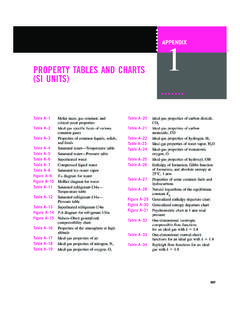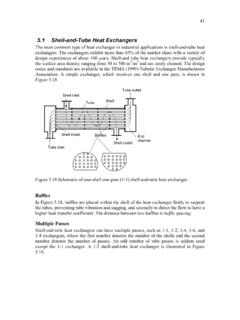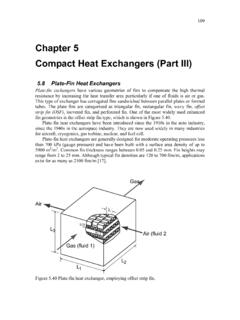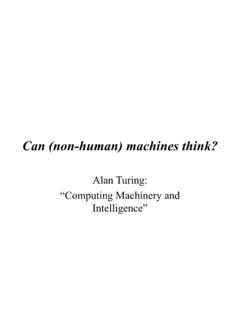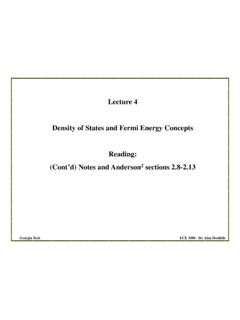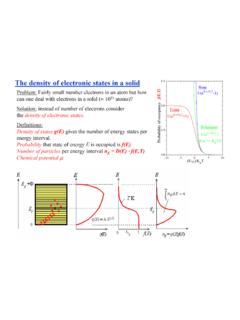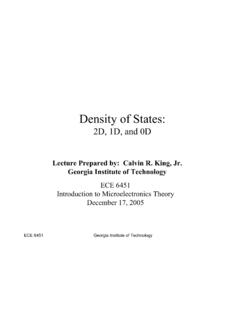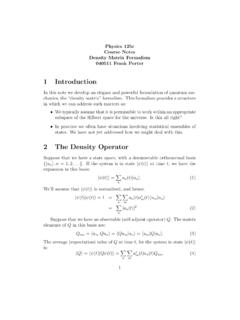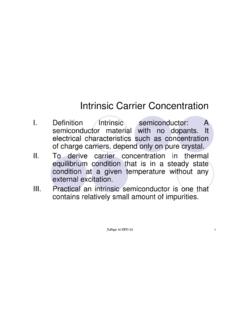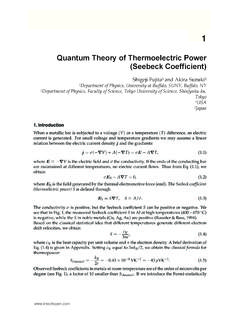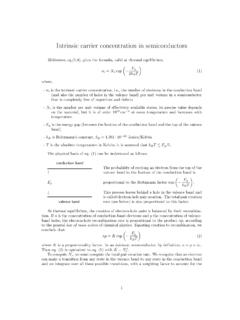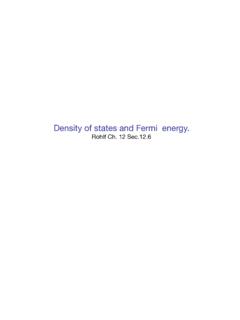Transcription of Chapter 11 Density of States, Fermi Energy and Energy Bands
1 11-1 Chapter 11 Density of states , Fermi Energy and Energy Bands Contents Chapter 11 Density of states , Fermi Energy and Energy Bands .. 11-1 Contents .. 11-1 Current and Energy Transport .. 11-1 Electron Density of states .. 11-2 Dispersion Relation .. 11-2 Effective Mass .. 11-3 Density of states .. 11-5 Fermi -Dirac Distribution .. 11-7 Electron Concentration .. 11-8 Fermi Energy in Metals .. 11-9 EXAMPLE Fermi Energy in Gold .. 11-11 Fermi Energy in Semiconductors .. 11-12 EXAMPLE Fermi Energy in Doped Semiconductors .. 11-13 Energy Bands .. 11-14 Multiple Bands .. 11-15 Direct and Indirect 11-16 Periodic Potential (Kronig-Penney Model) .. 11-17 Problems.
2 11-24 References .. 11-24 Current and Energy Transport The electric field E is interfered with two processes which are the electric current Density j and the temperature gradientT . The coefficients come from the Ohm s law and the Seebeck effect. The field can be written as 11-2 Tj ( ) where is the electrical conductivity and is the Seebeck coefficient. The heat flux (thermal current Density ) qis also interfered with both the electric field and the temperature gradientT . However, the coefficients are not readily attainable. Thomson in 1854 arrived at the relationship assuming that thermoelectric phenomena and thermal conduction are independent.
3 Later, Onsager [1] supported that relationship by presenting the reciprocal principle which was experimentally verified. The heat flux can be written as TkTjq ( ) where k is the thermal conductivity consisting of the electronic and lattice (or phonon) contributions to the thermal conductivity as lekkk ( ) In this Chapter , only the electronic contribution to the total thermal conductivity is used. TkTjqee ( ) We consider a one-dimensional analysis in this Chapter because most thermoelectric devices reasonably holds one-dimension, so that tensor notations are avoided. Electron Density of states Dispersion Relation From Equation ( ) (combining the Bohr model and the de Broglie wave), we have ph ( ) This is known as the de Broglie wavelength.
4 Using the definition of wavevector k = 2 / , we have 11-3 pk ( ) Knowing the momentum p = mv, the possible Energy states of a free electron is obtained mkmpmvE22212222 ( ) which is called the dispersion relation ( Energy or frequency-wavevector relation). Effective Mass In reality, an electron in a crystal experiences complex forces from the ionized atoms. We imagine that the atoms in the linear chain form the electrical periodic potential. If the free electron mass m is replaced by the effective mass m*, we can treat the motion of electrons in the conduction band as free electrons. An exact defined value of the wavevector k, however, implies complete uncertainty about the electron s position in real space.
5 Mathematically, localization can be described by expressing the state of the electron as a wave packet, in other words, a group velocity. The group velocity of electrons in Figure is the slope of the dispersion relation. kvg ( ) Since the wavelength is twice the lattice constant a, the boundaries at the zone in k-space is k = /a. The frequency associated with a wavevector of Energy E is Eand pk ( ) where the two equations are known as the Planck-Einstein relations. 11-4 Figure Dispersion relation of a group of electrons with a nearest neighbor interaction. Note that is linear for small k, and that k vanishes at the boundaries of the Brillouin zone (k = /a) kEvg 1 ( ) The derivative of Equation ( ) with respect to time is tkkEtkEtvg 22211 ( ) From Equation ( ), we have kmvg and tktvmg.
6 The force acting on the group of electrons is then tktvmFg ( ) Combining Equations ( ) and ( ) yields tvkEFg 222 ( ) This indicates that there is an effective mass m*, which will replace the electron mass m. 22211kEm ( ) 11-5 The effective mass m* is the second order of derivative of Energy with respect to wavevector, which is representative of the local curvature of the dispersion relation in three dimensional space. The effective mass is a tensor and may be obtained experimentally or numerically. Density of states Thermoelectric materials typically exhibit the directional behavior. Therefore, in general we have zzyyxxmkmkmkE22222 ( ) where mx, my, and mz are the principal effective masses in the x-, y-, z-directions and here k is the magnitude of the wavevector.
7 2222zyxkkkk ( ) This represents the surface of a sphere with radius k in k-space. We introduce a new wavevectors k and an effective mass m as 22222222zyxkkkmmkE ( ) Equating Equations ( ) and ( ), we have a relationship between the original wavevector and the new wavevector as xxxkmmk , yyykmmk , and zzzkmmk ( ) In Figure , we have the volume of a thin shell of radius k and thickness dk. kdkmmmmkdkdkdmmmmdkdkdkdkzyxzyxzyxzyx 2334 ( ) The volume of the smallest wavevector in a crystal of volume L3 is (2 /L)3 since L is the largest wavelength. The number of states between k and k + dk in three-dimensional space is then obtained (see Figure ) 11-6 kdmmmmLkdkkNzyx 332242 ( ) where the factor of 2 accounts for the electron spin (Pauli Exclusion Principle).
8 Now the Density of states g(k) is obtained by dividing the number of states N by the volume of the crystal L3. kdmmmmkdkkgzyx 322 ( ) (a) (b) Figure A constant Energy surface in k-space: (a) three-dimensional view, (b) lattice points for a spherical band in two-dimensional view. From Equation ( ), we have 212 Emk ( ) Differentiating this gives 2122 EmdEkd ( ) Replacing this into Equation ( ), m is eliminated. The Density of states per valley is finally obtained as 11-7 212322221 EmEgd ( ) where 31zyxdmmmm ( ) which is called the Density -of- states effective mass, and mx, my, and mz are the principal effective masses in the x-, y-, z-directions.
9 Most actual band structures for semiconductors have ellipsoidal Energy surfaces which require longitudinal and transverse effective masses in place of the three principal effective masses (Figure ). Therefore, the Density -of- states effective mass is expressed as 312tldmmm ( ) where lmis the longitudinal effective mass and tmis the transverse effective mass. (a) (b) Figure Constant electron Energy surfaces in the Brillouin zones (space or k-space): (a) a spherical band such as GaAs; (b) an ellipsoidal band such as Si. Si has six identical conduction Bands . Fermi -Dirac Distribution Although the classical free electron theory gave good results for electrical and thermal conductivities including Ohm s law in metals, it failed in certain other respects.
10 These failure was eliminated by having the free electron obeys the Fermi -Dirac distribution. The ground state is state of the N electron system at absolute zero. What happens as the temperature is increased? The solution is given by the Fermi -Dirac distribution. The kinetic Energy of the electron increases as the temperature is increased: some Energy levels are occupied 11-8 which were vacant at absolute zero, and some levels are vacant which were occupied at absolute zero (Figure ). The Fermi -Dirac distribution fo gives the probability that an orbital at Energy E will be occupied by an ideal electron in thermal equilibrium. 11 TkEEoBFeEf ( ) Figure Fermi -Dirac distribution at the various temperatures.


